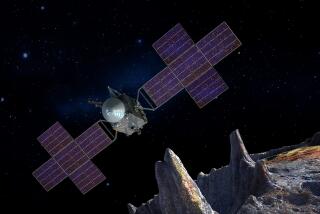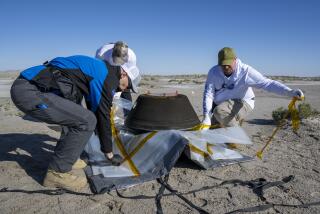Fly-By Studies Asteroid Origin
- Share via
An unprecedented close encounter between spacecraft and asteroid has shown scientists a glimpse of history, and may give them new insight into the origin of asteroids in the Earth’s vicinity.
Jet Propulsion Laboratory researchers announced Tuesday that asteroid Braille, the target of a fly-by by NASA’s Deep Space 1 craft, could be the “missing link” between one of the solar system’s largest asteroids and the many meteorites that have pelted Earth over the years. Braille--currently between the orbits of Earth and Mars--is coated with the same materials as the enormous Vesta, a “main belt” asteroid with a stable orbit between Mars and Jupiter.
Braille’s orbit is very eccentric and comes near the Earth at some points, making it a possible source of some Earth-bound meteorites. About 6% of the meteorites that have been recovered are believed to be related to Braille and Vesta.
“Vesta would be the bowling ball, Braille would be a chip off the ball, and these meteorites are chips off of the chip,” said Eileen Ryan of New Mexico Highlands University.
Vesta’s profile lends support to the idea. The 400-kilometer-wide asteroid has a 300-kilometer-wide crater, presumably the site of an impact millions--or billions--of years ago.
That impact may have liberated the fragment that became Braille. And Braille’s unusually slow rotation, which takes days rather than the typical nine or 10 hours, is a sign of a “tortured past,” Ryan said, that probably included some sort of a collision.
The analysis relied on matching the materials present in Braille to those in other objects. Various minerals exhibit distinctive “fingerprints” of light, color and intensity. By comparing Braille’s pattern with Vesta’s and the meteorites’, scientists determined that they were related. All showed the presence of pyroxene, commonly found in lava flows.
Long ago, molten rock flowed across Vesta’s surface. The surface hasn’t changed since, with the exception of the occasional collision, resulting in a host of smaller asteroids that stayed near Vesta. It now appears that at least one of those--Braille--moved much farther away.
“This is the triple crown,” said Nelson. “The excitement lies in the connections” among Vesta, the meteorites and Braille.
Attempts to take pictures at the nearest point of the fly-by were thwarted, possibly by Braille’s own dimness. Deep Space 1’s on-board navigator was unable to fix on Braille as it came closer, and so the high-resolution camera wasn’t pointed correctly.
As the craft passed the asteroid, it got a backward-glancing look, showing Braille as irregularly shaped and fairly small; about 2 kilometers long and 1 kilometer wide.
Asteroid Braille was discovered in 1992. Until recently, it was called 1992 KD, but was renamed in honor of Louis Braille, the inventor of the raised-dot Braille language used by the blind. The name was chosen to reflect the new “insights” that Braille might give into the origin of the universe.
Deep Space 1 was launched Oct. 24. The first spacecraft in NASA’s New Millennium project, it was designed to test a number of “high-risk” technologies that could be used in space exploration projects.
The primary goal of the flight was to validate a cadre of new systems: a computerized on-board navigator and problem-solver, an ion propulsion engine that could be faster and more efficient than conventional engines, and miniaturized scientific instruments, among others.
Mission manager Marc Rayman of JPL said the tests went well and that the scientific findings were “icing on the cake.”
Other possible encounters for Deep Space 1, if its mission is extended, include two comets that it would reach in 2001.
(BEGIN TEXT OF INFOBOX / INFOGRAPHIC)
Close Encounter
An unprecedented close encounter between NASA’s Deep Space 1 spacecraft and the asteroid Braille may give scientists new insight into the origins of asteroids that surround the Earth. JPL researchers believe that Braille could be the missing link between Vesta, one of the solar system’s largest asteroids, and numerous chunks of the same material that have fallen to Earth.






